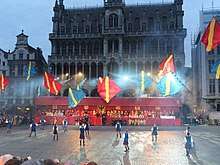Ommegang of Brussels
The Ommegang of Brussels is a traditional Ommegang, a type of medieval pageant, celebrated in Brussels, Belgium.
| Ommegang of Brussels | |
|---|---|
 Ommegang at the Grand Place of Brussels | |
| Status | Active |
| Frequency | Annual |
| Location(s) | Brussels |
| Country | Belgium |
| Inaugurated | 1930 |
| Most recent | June 26, 2019 & June 28, 2019 |
| Next event | |
| Participants | 1400 |
| Website | Official website |
Originally, it was the largest lustral procession of Brussels, which took place once a year, on the Sunday before Pentecost. Since 1930, the Ommegang of Brussels has taken the form of a historical reenactment of the entry of Emperor Charles V and his son Philip in Brussels in 1549.[1] Nowadays, it takes place twice a year, at the turn of June and July. The event is organised by Ommegang Oppidi Bruxellensis, an association close to the City of Brussels.
The term "Ommegang", in Latin "circumambulatio", means "moving around" in Dutch and it is an old historical evocation of Brussels. It joins the tradition of the great processions of notable riders and giants that are found everywhere in Belgium and northern France. Its starting point is the Sablon and it ends with a large spectacle at the Grand Place.
History
Origins
According to legend, the origin of the Ommegang goes back to a local devout woman named Beatrijs Soetkens. She had a vision in which the Virgin Mary instructed her to steal the miraculous statue of ‘Onze-Lieve-Vrouw op ‘t Stocxken’ (Our Lady on the little stick) in Antwerp, bring it to Brussels and place it in the chapel of the Crossbow Company. The woman stole the statue and, through a series of miraculous events, was able to bring it to Brussels by boat, in 1348. The statue of Mary was then solemnly placed in the chapel and venerated as the patron of the Crossbow Company. The Crossbow Company promised to hold an annual procession, called an 'Ommegang', in which the statue was carried through Brussels.
The original Ommegang (1348–1785)
Through the following decades, what was originally a religious procession took on gradually a more worldly outlook. The Ommegang of 1549 corresponds to a golden age of the procession. From the mid-16th century, the Ommegang not only celebrated the miraculous legend, but became intertwined with the Joyous Entry of Holy Roman Emperor Charles V. The Ommegang thus developed into an important religious and civil event in the annual calendar of Brussels.[2]
During the second half of the 16th century, the event was dependent on political and religious upheavals in the Spanish Low Countries. Between 1580 and 1585, when the city was in the hands of the Protestants, the procession was simply suppressed. In the 17th century, the event regained its luster, under the government of Albert VII and Isabella. In the 18th century, the decline of the demonstration began. The last (very small) Ommegang took place in 1785.

The revived Ommegang (1930–present)
In 1930, on the occasion of the 100th anniversary of Belgium, some history enthusiasts supported efforts to commemorate once again this demonstration, in the form of a historical procession. Given the success of this performance, it was decided to repeat it in subsequent years. This was the origin of the present Ommegang. The organising committee chose not to revive the ancestral "circumambulation", but to make it a spectacle reproducing and repeating the sumptuous Ommegang offered, in 1549, by the city of Brussels to Charles V and his son Philip II.
The current event brings together about 1,400 extras, including several dozen riders dressed in period costumes. There are also stilt walkers and giants such as the archangel Saint Michael, Saint Gudula and the Bayard horse. Since 2011, each year, a personality from the world of the arts is entrusted the role of herald and comments on the show, at the Grand Place. Jean-Pierre Castaldi, Stéphane Bern, Jacques Weber, Francis Huster, Éric-Emmanuel Schmitt and Patrick Poivre d'Arvor have successively lent themselves to the exercise.
Although it has become a historical show, the Ommegang nevertheless preserves many traditional and authentic elements, such as the presence of the Brussels Lineages, the Oaths of Crossbowmen and the Virgin of Victories, and remains in the minds of the people of Brussels a major event of the year.
See also
References
- "1,400 extras for the Ommegang 2017". Focus on Belgium. Retrieved 7 July 2017.
- Rudi Schrever, Onze-Lieve-Vrouw-ter-Zavelkerk in Brussel'' (in Dutch)
Further reading
- 1960: Leo van Puyvelde, L'Ommegang de 1615 à Bruxelles, Brussels, Éditions du Marais, 1960.
- 1975: Jean Jacquot, Fêtes et cérémonies au temps de Charles Quint., Fédération internationale des sociétés et instituts pour l'étude de la Renaissance, 1975.
- 1980: Arthur Haulot, Cette nuit-là, l'Ommegang de Bruxelles, Brussels, Ed. Trois Arches, 1980.
- 1997: Daniel Frankignioul (dir.), Brigitte Twyffels, Michel Staes, Claude Flagel, Alfred Willis, Pleins Feux sur l'Ommegang, La Reconstitution du Cortège en 1930 par Albert Marinus., Woluwé-Saint-Lambert, Fondation Albert Marinus, 1997.
- 1997: Rosine De Dijn et Siegfried Himmer, La Grand-Place de Bruxelles, fastueux décor de l'Ommegang, Eupen, Grenz-Echo Editions, 1997.
- 1999: Isabelle Lecomte-Depoorter, Ommegang, with illustrations of René Follet, Éditions Glénat, 1999
- 2007: Olivier de Trazegnies, Louis-Philippe Breydel, L'Ommegang, (trilingual), Brussels, Renaissance du Livre, 2007.